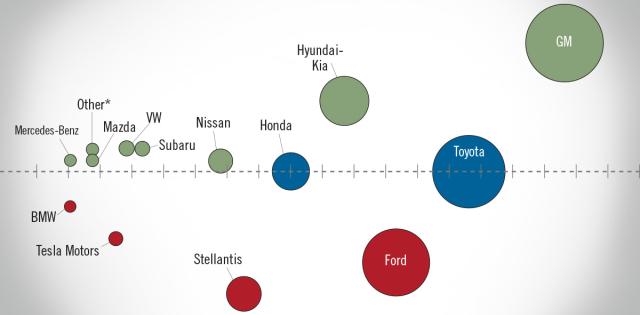As the first quarter of 2020 has come to a close, the National Automobile Dealers Association (NADA) issued an analysis of U.S. auto sales and the economy, including the initial impact of the COVID-19 pandemic on both.
“New-vehicle sales were on a healthy trajectory until mid-March, when we saw widespread social distancing measures due to the coronavirus go into effect and dramatically slow sales,” said NADA chief economist Patrick Manzi. “However, most dealerships remained open for essential services through much of March, which helped blunt the decline in new-vehicle sales somewhat.”
March saw a 37.9% decline in new vehicle sales compared to March of 2019, while the first quarter of 2020 experienced a 12.7% decline compared to the Q1 2019. Consumer preference toward light-trucks over light vehicles continued in Q1 with light-trucks representing 74.1% of all new vehicles sold.
To promote new vehicle sales, auto makers have drastically increased their incentives. Average incentives reached $4,800 per vehicle in the last week of March – setting a new record. Pickup truck incentives also set a new record, reaching $7,200 per vehicle in the last week of March. Additionally, many manufacturers have begun offering zero percent interest loans for periods of up to 84 months, at a time when most OEMs have ceased production or have been quickly retooled to manufacture critically needed medical supplies.
NADA now estimates new light-vehicle sales between 13 million and 13.5 million units for the year – down from an original 2020 sales forecast of 16.8 million units.
“While the impact of the coronavirus is uncertain at this point, we do know that the leases on 1.8 million vehicles are set to expire between March and July according to data from J.D. Power, and most of these customers will be in the market for a replacement vehicle,” added Manzi. “Additionally, once Americans return to work, we expect pent up demand, but just how much is still ambiguous.”
At the macrolevel, the coronavirus has impacted the U.S. GDP, jobs, and equities markets – all culminating in lower consumer confidence and decreased auto sales. Initial jobless claims have totaled more than 10 million in the last two weeks. Additionally, the March jobs report indicated the unemployment rate rose to 4.4%, however the data for this report was collected nearly three weeks ago and does not capture the full extent of job losses across the country. Furthermore, GDP estimates are continuously being amended with many estimating that second quarter GDP will decline by more than 30% on an annualized basis. Equities markets remain incredibly volatile with the Dow having its worst quarter since 1987, dropping 23.2%. Likewise, the S&P and Nasdaq posted a 20% and 14% drop, respectively. Furthermore, consumer confidence dropped to 89.1, a 11.9 index point drop from February’s reading of 101, and the fourth largest decline in nearly half a century.
“As the coronavirus continues to hold the country captive with stay-at-home orders across much of the U.S. in place, we will continue to monitor for the impact on the economy, auto production, sales and dealers,” said Manzi. “In light of the recently passed $2 trillion stimulus bill and other efforts by the government, my hope is that consumer confidence will increase and consumers will be ready to spend once they return to work en masse.”
Click here to read the full March 2020 NADA Market Beat report.











